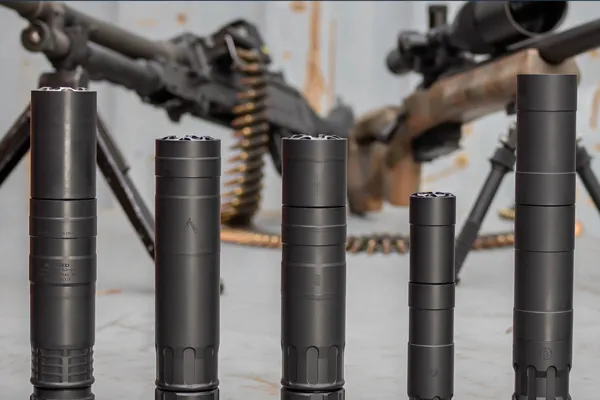
Choosing a Suppressor
Introduction
Choosing the correct suppressor (silencer) for your firearm can significantly impact your shooting experience, reducing noise and recoil while enhancing accuracy. Here’s a comprehensive guide on how to choose the right suppressor:
1. Understand the Basics of Suppressors
Suppressors, commonly known as silencers, are devices attached to the muzzle of a firearm to reduce the noise and muzzle flash generated when firing. They work by trapping and slowing the escaping gases that propel the bullet, which in turn reduces the sound. The Maxim Silencer, patented in 1909, was a tubular device attached to the barrel of a firearm which reduces noise and muzzle flash when fired. At the same time, silencers and mufflers for internal combustion engines were being created using the same noise reduction techniques. Basically a muffler and a suppressor are the same.
2. Know Your Firearm and Caliber
Before selecting a suppressor, identify the specific firearm and caliber you plan to use it with. Suppressors are often caliber-specific, meaning they are designed to handle certain bullet sizes and pressures. Ensure that the suppressor you choose is compatible with your firearm’s caliber to achieve optimal performance and safety.
3. Decide on the Suppressor Type
There are several types of suppressors to consider:
· Direct Thread Suppressors: These screw directly onto the threaded barrel of the firearm. They are simple, reliable, and typically lighter.
· Quick Detach (QD) Suppressors: These use a mounting system that allows for easy attachment and detachment. They are convenient for switching between firearms but can be heavier and more expensive.
· Integral Suppressors: Built into the barrel of the firearm, these offer a shorter overall configuration but are firearm-specific and less versatile.
4. Evaluate the Suppressor’s Material
Suppressors are made from various materials, each offering different levels of durability, weight, and cost. Many suppressors use more than one of these materials to achieve a good balance of weight, durability and performance.
· Aluminum: Lightweight and affordable, but less durable under high rates of fire.
· Stainless Steel: Durable and corrosion-resistant, suitable for high rates of fire.
· Titanium: Lightweight and extremely durable, but more expensive.
· Inconel: High-performance alloy used for extreme durability and resistance to heat and corrosion, often found in premium suppressors.
5. Consider the Suppressor’s Length and Weight
The length and weight of the suppressor affect the firearm’s balance and handling. A longer suppressor generally provides better noise reduction but adds more weight and length to the firearm, which can affect maneuverability. Consider your shooting needs and preferences when choosing the length and weight.
6. Check for Noise Reduction Capabilities
Suppressors vary in their ability to reduce noise. The noise reduction level is typically measured in decibels (dB). Look for a suppressor that offers substantial noise reduction while still being practical for your intended use. Most quality suppressors reduce noise by 20-35 dB. Each 10 dB basically equates to being half the perceived noise level or loudness. Keep in mind that a suppressor will not be able to get rid of the sonic crack of bullets traveling faster than the speed of sound. This is typically around 1,000+ feet per second (fps). Semi-automatic firearms may be louder than the capability of the suppressor as the action opens before all the gas is expelled producing what is referred to as Port Pop.
7. Research Legal Requirements and Paperwork
Suppressors are regulated by the National Firearms Act (NFA) in the United States. This means you’ll need to complete the appropriate paperwork, including an ATF Form 4, submit fingerprints and photos, and pay a $200 tax stamp. Ensure you understand and comply with all local, state, and federal laws before purchasing a suppressor.
8. Read Reviews and Seek Recommendations
Before making a purchase, read reviews from other users and seek recommendations from knowledgeable sources. Forums, online reviews, and expert opinions can provide valuable insights into the performance and reliability of different suppressor models.
9. Consider the Manufacturer’s Warranty and Customer Support
A good warranty and reliable customer support can provide peace of mind. Choose a reputable manufacturer that stands behind their product and offers support in case you encounter any issues. Many people expect these, like firearms, to last and perform for many generations.
Conclusion
Selecting the right suppressor involves understanding your firearm and caliber, evaluating suppressor types and materials, and considering factors such as length, weight, and noise reduction capabilities. By doing thorough research and understanding the legal requirements, you can make an informed decision and enhance your shooting experience with the right suppressor.

Yowie Outdoors
Blaine, MN 55449

Facebook
Instagram
X
Youtube
TikTok